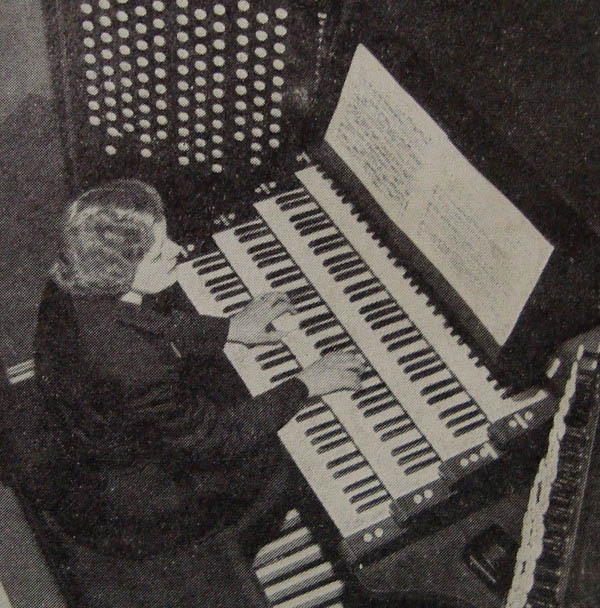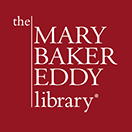Women of History: Ruth Barrett Phelps

Ruth Barrett Phelps plays the Aeolian-Skinner organ in the Mother Church Extension, c. 1952.
Gordon Converse / ©The Christian Science Monitor.
For organ aficionados, the great instrument in the domed Extension of The Mother Church in Boston (The First Church of Christ, Scientist) is a must-hear, and must-see, experience. Lawrence Phelps (1922–1999), who oversaw the instrument’s 1950–1952 installation, is almost as well-known to many organ lovers as the company that made it. Books and articles about the organ often focus on him—with a mere parenthetical given to Ruth Barrett Phelps (1899–1980), who at the time was both his wife and the Mother Church organist. But digging beneath those surface mentions, we find a true woman of history.
She was born Anna Ruth Barrett in Albany, New York, to Isaac B. Barrett and Fanny Taylor Barrett. When she was very young, her mother found Christian Science and joined the church in 1902. She later wrote in the Christian Science Sentinel of the help her religion gave in raising children.1
Following in her mother’s footsteps, Ruth Barrett joined The Mother Church in 1920. During this time she was becoming an accomplished organist in New York City—quite an unusual pursuit for a woman at that time. In addition to studying under well-known teachers including Lilian Carpenter, Lynwood Farnam, Ernest Mitchell, and Fritz Heitmann, she also studied accompaniment with the famous pianist Frank La Forge. She attended both the Guilmant Organ School in New York City and the prestigious American School of Music in Fontainebleau, France.2
A 1923 advertisement for an event at the Washington Heights Musical Club in New York City lists one of the organists as “Ruth Barrett (AAGO).”3 That affiliation indicated she had already acquired the second-highest level of certification from the American Guild of Organists (AGO)—that of associateship.4 Barrett was a member of the Society of Theater Organists, for which she had to pass an examination. That is significant, indicating her ability to work successfully in the vaudeville era, when travelling acts performed in theaters throughout the country.5
The link between religious practice and professional success was a theme for Barrett during much of her life. “Early in my career came the realization that progress in Christian Science could be made only as I put God first,” she wrote in 1941. “This has been a wonderful help in my profession and has made possible the opportunity for service in many unexpected ways.”6
By the early 1930s, Barrett was playing the organ for the Christian Science radio program on the Columbia Broadcasting Network’s “Church of the Air,” broadcast nationally through local stations.7 During this time she was organist for Third Church of Christ, Scientist, New York City, and occasionally played as a substitute at The Mother Church. In 1934 she moved to Boston, when the Christian Science Board of Directors appointed her the first woman to be a permanent Mother Church organist. She continued in that capacity until 1961, making her term of service the longest to date in the church’s history.8 That was no small achievement for a woman; not only did men dominate the field (only one of Barrett’s notable instructors was a woman) but “a rotation of organists had usually been the practice” in Christian Science churches, The Mother Church included.9
Barrett set high standards for her work, both professionally and spiritually. This is perhaps best summed up in a statement from her article “Our Musical Standard,” published in the Sentinel on July 11, 1936:
We strive to obtain for The Mother Church the finest quality of music according to the generally recognized high standard. Yet this is not enough. Consistent mental work for the music at our services, constructive criticism, co-operation, and support, help to bring out a more complete demonstration, result in better renditions, and constantly unfold ways and means of improvement.10
A couple of years following her appointment at The Mother Church, Barrett married Walter M. Arno (1883–1943), a fellow organist and piano teacher. Together they performed and played both in and out of church, until his passing in 1943. At that time she had just begun writing what became a monthly review column in The Christian Science Monitor, “New Devotional Music.” It continued for several years and helped her career to continue flourishing, combining her love of music and dedication to the church.
Also in 1943 she edited her second volume of music, The Sacred Hour at the Piano11, intended as a “useful and artistic book of compositions suitable for amateur and professional pianists.” This was a followup to her 1939 publication of The Sacred Hour at the Organ—a compilation intended to satisfy “a growing interest in the music of religious services, and to meet an increasing demand for organ publications of excellent quality on the part of church musicians and congregations alike.” While its contents were primarily intended for use in Christian Science services, it offered music “of such spiritual quality and beauty” as to be “useful and suitable for other services.” In 1953 she published a second volume of The Sacred Hour at the Organ.12
Throughout her tenure, she gave organ recitals at The Mother Church, as well as other locations. This included broadcasts on Boston radio station WBZ, where her performances were at the time the only ones broadcast live.13
In 1949 she was the first woman to become Dean of the Massachusetts chapter of the AGO.14 While serving in this capacity, she helped the chapter achieve several “firsts,” including the establishment of classes to promote Guild examinations and certification, a new Choir Master examination, and a joint meeting with the New England Choir Directors’ Guild.15 Under her leadership the AGO held its twentieth national convention in Boston in June 1950. Both Phelps and the church played a role in this convention, hosting lectures and recitals.16 She also lobbied there for greater recognition and pay for church organists.17 18
In 1948 she worked with Lawrence Phelps (1923–1999) of the Aeolian-Skinner company, on a comprehensive study of the two Mother Church organs. It was decided that both needed to be completely rebuilt. She and Phelps collaborated on the tonal design of the instruments, to produce a robust, versatile, and modern sound. Two years into the project, they got married, and she took the name by which we know her today.19
The rebuilt smaller organ in the Original Mother Church was first played in 1951. The new organ in the Extension followed in 1952—Aeolian-Skinner’s Opus 1203. The largest single organ ever built by the company, it contains more than 13,000 pipes and is designed to meet the need for four specific functions: accompaniment to congregational and solo singing; performance recitals; broadcasting; and recording.20 Sixty-eight years later, this organ is still in very active service. You can hear it by attending any church service held in the Mother Church Extension, or by listening to services online.
After retiring Phelps continued her musical career. In 1966 she published Anthology of Organ Music Selected for Christian Science Services. Along with selections from Bach, Liszt, and Saint-Saens, it included a composition of her own.21 In 1969 she moved to Burlingame, California, where she lived until the time of her passing at the age of 81.
Throughout her career, Ruth Barrett Phelps made recordings on the organs in the Mother Church Extension—both the original and the Aeolian-Skinner instrument that replaced it. Click here to listen to a recording of her playing a selection on the original organ, circa the late 1930s—Cesar Franck’s Trois Chorals: No. 3 in A Minor (F276970). For more on Phelps, listen to the Seekers and Scholars podcast episode Ruth Barrett Phelps—presiding over the king of instruments.
- Fanny T. Barrett, testimony, Christian Science Sentinel, 27 July 1935, 964-965, https://sentinel.christianscience.com/issues/1935/7/37-48/many-years-ago-christian-science-was-brought-to-my
- Harold Winthrop Martin, “A History of The American Guild of Organists in Boston Massachusetts (1905–1954)” (master’s thesis, Union Theological Seminary, 1954), ch. XVII.
- “Organists’ Open Meeting,” The Washington Heights Music Club, advertisement, The Christian Science Monitor, 8 May 1923, 2.
- For the current standards for this certification, see “AGO Associateship Certification,” The American Guild of Organists, accessed 18 February 2020, https://www.agohq.org/associateship-certification/ “AGO Certification,” The American Guild of Organists, accessed 18 February 2020, https://www.agohq.org/certification/
- “The Examinations,” Notes and Reviews, The American Organist 5, no. 4 (April 1922), 145. https://books.google.com/books?id=GpZFAQAAMAAJ&lpg=PA145&ots=8wG-qEdF72&dq=society%20theatre%20organist%20barrett&pg=PA145#v=onepage&q=society%20theatre%20organist%20barrett&f=false
- Ruth Barrett Arno, testimony, Sentinel, 5 July 1941, 875-876, https://sentinel.christianscience.com/issues/1941/7/43-44/it-is-with-deep-gratitude-that-i-offer-my-testimony-of
- In Boston, it was broadcast on WAAB. Lloyd C. Greene, “Radio Broadcasts,” Boston Globe 27 May 1933, 15.
- “Organists, TMC” and “Organists in The Mother Church” circa 1972, The First Church of Christ, Scientist – Music – Organists and Soloists, Subject File Box 197.
- Martin, “A History of The American Guild of Organists in Boston Massachusetts (1905–1954),” ch. XVII.
- Ruth Barrett Arno, “Our Musical Standard,” Sentinel, 11 July 1936, 900, https://sentinel.christianscience.com/issues/1936/7/38-45/general-activities-meeting-of-the-mother-church
- Ruth Barrett Arno, The Sacred Hour at the Piano (New York: Carl Fischer, 1943)
- Ruth Barrett Phelps, Second Volume of The Sacred Hour at the Organ (New York: Carl Fischer, 1953)
- “Mrs. Arno to Give Recitals Over Air,” Monitor, 10 September 1947, 4.
- “AGO History—Past Deans’ List,” The American Guild of Organists, accessed 18 February 2020, http://www.bostonago.org/chapter/history-past-deans-list/
- Martin, “A History,” ch. XVII.
- “Organist Guild Told Need For Choral Music,” Monitor, 23 June 1950, 1.
- “Organists Consider Methods to Boost Salaries, Prestige,” Boston Herald, 21 June 1950.
- “Pay for Music Stirs Organists’ Discord,” Canton Repository, 25 June 1950.
- Burton K. Tidwell, Lawrence Phelps, Organ Builder (Richmond, Virginia: The Organ Historical Society, 2015), 7-8. Tidwell, “The Organ at The First Church of Christ, Scientist: The Mother Church,” The Tracker: Journal of the Organ Historical Society, Vol. 44, No. 1 (January 2000), 34–40. Lawrence Phelps, “Great Organ Placed in C. S. Mother Church,” Diapason, No. 8 (1 July 1952),1, 2, 13.
- “Mother Church Introduces Rebuilt, Vastly Larger Organ, With 13,389 Pipes,” Monitor, 4 June 1952, 6.
- Ruth Barrett Phelps, Anthology of Organ Music (New York: Carl Fischer, 1966).

